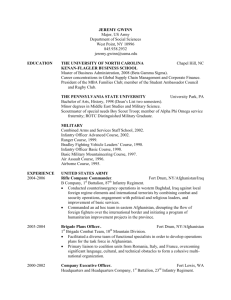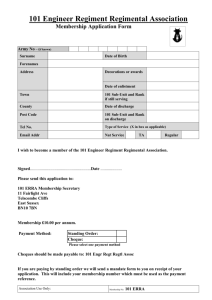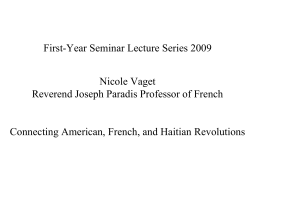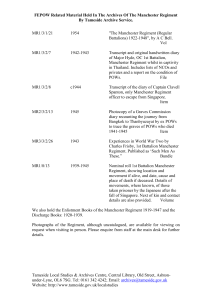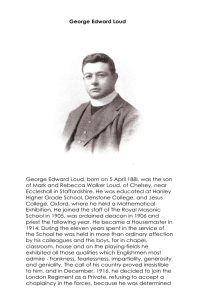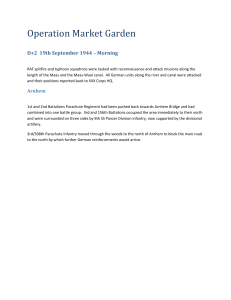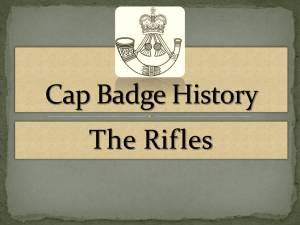A mess chit from the Ancien Regime
advertisement
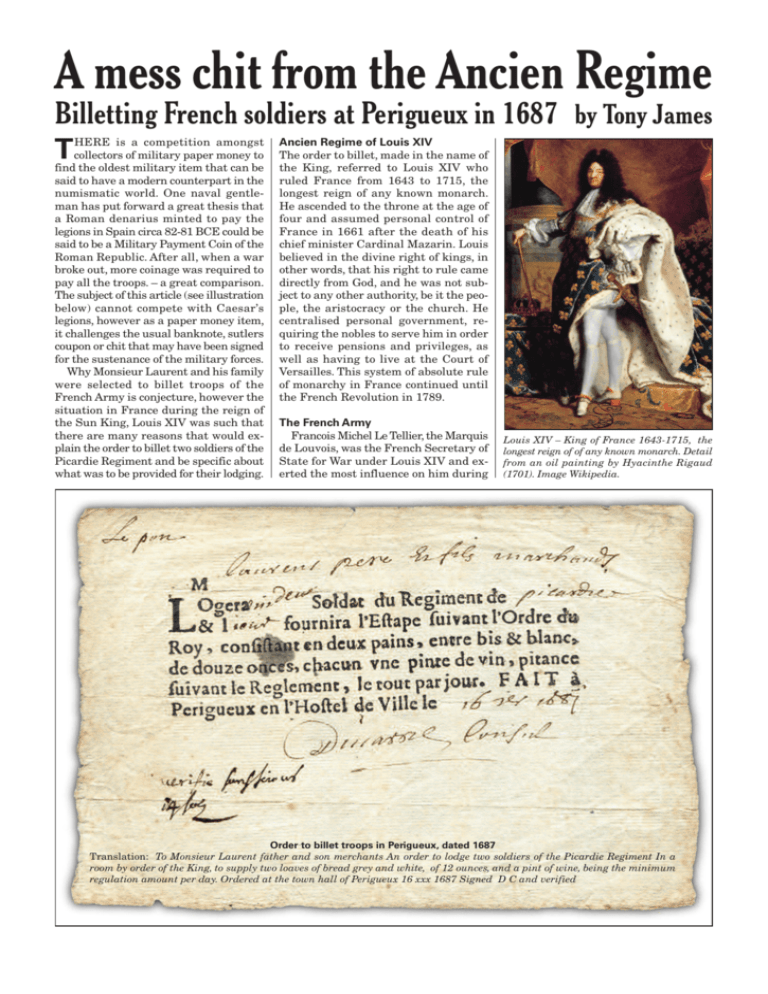
A mess chit from the Ancien Regime Billetting French soldiers at Perigueux in 1687 by Tony James T HERE is a competition amongst collectors of military paper money to find the oldest military item that can be said to have a modern counterpart in the numismatic world. One naval gentleman has put forward a great thesis that a Roman denarius minted to pay the legions in Spain circa 82-81 BCE could be said to be a Military Payment Coin of the Roman Republic. After all, when a war broke out, more coinage was required to pay all the troops. – a great comparison. The subject of this article (see illustration below) cannot compete with Caesar’s legions, however as a paper money item, it challenges the usual banknote, sutlers coupon or chit that may have been signed for the sustenance of the military forces. Why Monsieur Laurent and his family were selected to billet troops of the French Army is conjecture, however the situation in France during the reign of the Sun King, Louis XIV was such that there are many reasons that would explain the order to billet two soldiers of the Picardie Regiment and be specific about what was to be provided for their lodging. Ancien Regime of Louis XIV The order to billet, made in the name of the King, referred to Louis XIV who ruled France from 1643 to 1715, the longest reign of any known monarch. He ascended to the throne at the age of four and assumed personal control of France in 1661 after the death of his chief minister Cardinal Mazarin. Louis believed in the divine right of kings, in other words, that his right to rule came directly from God, and he was not subject to any other authority, be it the people, the aristocracy or the church. He centralised personal government, requiring the nobles to serve him in order to receive pensions and privileges, as well as having to live at the Court of Versailles. This system of absolute rule of monarchy in France continued until the French Revolution in 1789. The French Army Francois Michel Le Tellier, the Marquis de Louvois, was the French Secretary of State for War under Louis XIV and exerted the most influence on him during Louis XIV – King of France 1643-1715, the longest reign of of any known monarch. Detail from an oil painting by Hyacinthe Rigaud (1701). Image Wikipedia. Order to billet troops in Perigueux, dated 1687 Translation: To Monsieur Laurent father and son merchants An order to lodge two soldiers of the Picardie Regiment In a room by order of the King, to supply two loaves of bread grey and white, of 12 ounces, and a pint of wine, being the minimum regulation amount per day. Ordered at the town hall of Perigueux 16 xxx 1687 Signed D C and verified The Cathedral of Saint Front, Perigueux as it stands today. Built originally as an Abbey it has been the city’s cathedral since 1669. Image Wikipedia. the period 1677-91. Louvois’ main claim to fame was his contribution in reorganizing the French Army which made it one of the most formidable in Europe. His father, Michel Le Tellier, groomed his son to replace him as Secretary for War, the position to which he succeeded in 1677. Francois created an efficient provisioning system for the army, introduced the bayonet and flintlock rifle, brought about a closer coordination of artillery and engineers with the infantry and created promotional grades of commissions that did not have to be purchased by officers. The new French Army of the 17th century increased to between 340,000 and 420,000 depending upon sources of information, fighting four wars between 1667 and 1713. Les Vieux Corps - Regiment Picardie Monsieur Laurent received the two boarders from the Picardie regiment, and it must have been interesting with his two guests speaking in a different accent of the north of France. The reputation of the regiment as one of the oldest of the French Army would be mixed, uniformed and armed soldiers were not well paid or provided with good footwear and to provide two loaves of bread and wine would have been a daily imposition, even for a merchant. The Picardie Infantry Regiment, created as “Bande de Picardi” in 1479, was officially raised in 1558 by Henri II and ranked first among the French Line Infantry regiments, with seniority after the French and Swiss Guards regi- ments. It was part of what is known as Les Vieux Corps (The Old Corps). The regiment was reorganised in May 1569 into three battalions along with the rest of the French infantry. The Picardie Regiment, raised in Picardy a northern province of France, served the country throughout the sixteenth century in various conflicts and after the Peace of Vervins was quartered in Picardy until 1615, being one of the few regiments not disbanded in the demobilisation of 1601. The regiment saw action in 1643 in the Battle of Rocroy in the Ardennes and its next action was at the siege of Philippesbourg in 1688 during the Nine Years War. The colours or standard of the colonel of the Regiment de Picardie 1585-1780 were a white greek cross on a white background, while the “drapeaux d’ordonnance” or regimental colours were a white greek cross on a red background. In 1685, orders were given for regiments to wear prescribed colours. The Old Guard and royal regiments wore blue, while the Swiss Guard wore red, and the regular infantry were ordered to wear gray and white. Five years later each regiment was given a colour, for 88 regiments it was gray with red reverses and for 14 royal and princely regiments it was blue. The infantry were armed with muskets and pikes. With Louvois as Minister of the Army there was no shortage of weapons and gunpowder, even if they didn’t have footwear and went hungry. After the period covered by this article the regiment saw action at Valmy in 1792, Fleurus in 1794, Moeskirch and Biberach in 1800, Milliana in 1842 and Guise, Verdin, Somme, Yser and Ourcq during WWI. During WWII the regiment fought in Belgium, where it defended Mont-Saint-Guilbert but suffered Battle of Valmy, 20 September 1792. The Picardie Regiment served in this battle and many others up to and including World War II. Image Wikipedia. any liberty of conscience or worship that might have been implied in the text of the Revocation of the Edict of Nantes and declared his support for his king with the phrase “Sa majesté veut qu’on fasse sentir les dernières rigueurs a ceux qui ne voudront pas se faire de sa religion” (“His Majesty wishes the worst harshness on those who do not partake of his religion.”) The persecution got out of hand, causing outrage in England and literature protesting the savage treatment of Huguenots circulated throughout Europe. Most Huguenots left France for countries such as Switzerland, the Netherlands, England and German territories. Louis claimed that the Protestant population of France of eight to nine hundred thousand was reduced to between 1,000 and 1500 by 1686. While the troops of the Picardie regiment may not have been involved in the Dragonnade practices, the act of billeting troops, who were not native to the area and therefore less subject to favouritism, would indicate that there was some unrest in the area. The location of the town of Perigueux in the southern Bordeaux region of France, while in a religious area with strong Roman Catholic ties, was still close to an area that saw another Huguenot revolt. 1 Franc of the Chamber of Commerce of Perigueux dated 5 Novembre 1917. casualties of 65 percent. The regiment rebuilt in Cher, was dissolved in 1942 but continued fighting as partisans in Berry and was re-constituted upon liberation. In the 21st century it is a motorised infantry regiment with VAB (“Véhicule de l’Avant Blindé” or Armoured Vanguard Vehicle) armoured personnel carriers and forms part of the 1st Mechanised Brigade of the French Army. The motto of the regiment today is “On ne relève pas Picardie” meaning “Picardie (the regiment) is never relieved.” The interesting story is told that in 1636, the officers of the regiment were arguing with those of the Royal Scots over which regiment was older. The Picardie claimed that they had been on guard at Christ’s tomb to which the Royal Scots replied that had they been on guard, Christ’s body would not have disappeared. The French conceded the seniority and gave the Royal Scots, who were sometimes held in contempt as mercenaries in France, the nickname of “Pontius Pilate’s Bodyguard.” Dragonnades In 1681 Louis instituted a “dragonnades” policy to intimidate Huguenot families into either leaving France or re-converting to Catholicism. When the Treaty of Nantes was revoked in 1685, withdrawing the privileges and toleration that the French Protestants had enjoyed since 1598, Louis ordered the destruction of Huguenot churches and the closure of their schools. The soldiers of the French Army were drawn from the lowest order of the unemployed and were usually underpaid and underfed. The ill-disciplined soldiers were billeted in Protestant households. These members of regiments of dragoons were mounted infantry used for what was called “internal security duties,” effectively an instrument to persecute the Huguenots. Selective and coercive quartering of these stand-over troops was commenced in Poitou (not far from Perigueux) in 1681 by the local administrator - Intendent Rene de Marillac. While possibly not organized by the central government, the practice was certainly condoned by Louvois, who ignored Camisards Revolt This was another revolt by Huguenots who were known as Camisards in the Cevennes, an isolated region in southwest France. The revolt broke out in 1702, with fighting reaching its peak in 1704, and a rear-guard action that persisted until 1710. It was only in 1715 that the parties agreed on a final peace. Camisard in the local Occitan language comes from the name for a type of linen smock or shirt known as a camisa worn by the peasants and was worn instead of any sort of uniform. The term camisada is also used in the sense of a night attack, derived from a feature of their tactics. The name Black Camisard referred to Protestants, while White Camisards were Catholics organised to control the opposition. Both sides were known to commit atrocities during the revolt. The city of Perigueux This WWI “Bon” (above) issued by the Chamber of Commerce of Perigueux depicts some of the history of the city. Michel de Montaigne, at left, born at the family Chateau de Montaigne near Perigueux (1533-1592) was one of the most powerful writers of the French Renaissance, He used the essay as his literary genre and is considered to be the father of Modern Skepticism influencing Descartes, Pascal, Rousseau, Emerson and Nietzsche among others.
